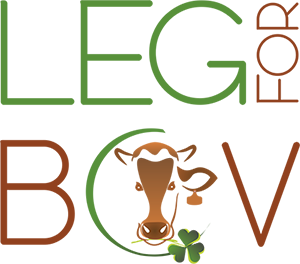
No XV Encontro Nacional da Química dos Alimentos foi apresentado um trabalho intitulado sobre o efeito da dieta na estabilidade lipídica e da cor da carne de novilhos alimentados com as dietas desenvolvidas no âmbito do projeto.
https://xveqa.events.chemistry.pt/
Lipid and colour stability of beef from concentrate- and haylage-fed bulls
Jerónimo E1,2, Fialho L1, Almeida J3, Portugal AP3, Francisco AE3,4, Santos-Silva J3,4
1 Centro de Biotecnologia Agrícola e Agro-Alimentar do Alentejo (CEBAL)/Instituto Politécnico de Beja (IPBeja), Beja, Portugal
2 MED – Mediterranean Institute for Agriculture, Environment and Development, CEBAL, Beja, Portugal
3 Instituto Nacional de Investigação Agraria e Veterinária, Polo de Investigação da Fonte Boa (INIAV-Fonte Boa), Vale Santarém, Portugal
4 Centro Investigação Interdisciplinar em Sanidade Animal (CIISA), Avenida da Universidade Técnica, Lisboa, Portugal
Email: Este endereço de email está protegido contra piratas. Necessita ativar o JavaScript para o visualizar.
Environmental sustainability, the safety and nutritional quality of meat are currently the main challenges of beef production systems. In Portugal, bulls and heifers are fed during fattening on concentrate-based diets mainly composed of cereals and oilseed derivatives (eg. soybean meal), mostly imported raw materials. The use of forage-based diets and the reduction of cereals in the concentrate fraction by replacement with agro-industrial by-products were explored to reduce the environmental impact of beef production systems. Portugal has good edaphoclimatic conditions for produce good quality haylages, which can be a substitute for conventional raw materials. In addition to the possible impact of replacing conventional raw materials with haylage on animal performance and feed efficiency, it is important to evaluate the effect of this dietary strategy on meat quality. So, the objective of this study was to evaluate the lipid and colour stability of meat from animals fed a concentrate diet or fed diets in which part of the concentrate was replaced with haylage.
Sixteen Limousine x (crossbred Alentejano) crossbred bulls and 16 heifers with 5-10 months of age and 167-272 kg live weight were used in the experiment. Animals were blocked by sex and weight and were distributed for 16 pens with 2 animals per pen, being attributed one of the following 4 dietary treatments to 4 pens (2 males and 2 females): concentrated based diet (Control); and 3 Total Mixed Diets including 3 different haylages and concentrate at a ratio 50:50 dry matter. The haylages were produced from Persian clover (Trifolium resupinatum) and from 2 biodiverse mixtures (Speedmix and Tritimix - Fertiprado, Portugal). The bulls were slaughtered with an average live weight of 534 ± 39.5 kg and the heifers with 406 ± 45.8 kg. On the 3rd day post-slaughter, Longissimus thoracis (LT) muscle was collected and four sub-samples of LT with 2 cm thick were stored under vacuum at 2°C under continuous light during 3, 7, 14 and 21 days after slaughter for evaluation of the colour and lipid stability. On each day of the ageing period, a sub-sample of LT was removed from the bag and after 60 min to allow blooming the colour parameters were determined. After colour evaluation, the LT muscle was vacuum-packed and stored at −80°C until lipid oxidation analysis. Meat colour was evaluated in the CIELAB system using a CR-400 chromometer (Konica Minolta, Japan). Lipid oxidation analysis was performed in cooked meat. The meat was cooked at 70°C in a water bath, and lipid oxidation was evaluated in a sub-sample immediately after cooking and in another sub-sample maintained at 4°C until 3 days after cooking. Lipid oxidation of meat was assessed through quantification of thiobarbituric acid reactive substances (TBARS) and expressed as mg of malonaldehyde (MDA)/kg of muscle. All diets were characterized for antioxidant activity by ferric reducing antioxidant power (FRAP) and trolox equivalent antioxidant capacity (TEAC) assays.
Meat colour parameters were not affected by diet, but varied over ageing period with a linear increase of the redness (a*, P=0.038) and saturation (C, P=0.041). Colour stability (ΔE), determined by the cumulative difference of the colour parameters L*, a* and b* evaluated at days 7, 14 and 21 reported to the correspondent values obtained at day 3 post slaughter, increased linearly over ageing period (P=0.014). However, even after 21 days the average values of ΔE were below 6, the threshold value for consumers' perception of meat colour changes. On cooking day, the lipid oxidation was lower for meat from animals fed Speedmix and Tritimix haylage diets (0.10 mg MDA/kg muscle) than those fed Control diet (0.17 mg MDA/kg muscle), while Persian clover haylage diet resulted in intermediate values of lipid oxidation (P=0.018). Conversely, after 3 days of storage, the lipid oxidation levels in cooked meat were not affected by dietary treatment (P=0.661, 2.93 mg MDA/kg muscle). At cooking day, the meat lipid oxidation increased quadratically over the ageing period (P=0.001), ranging from 0.13 and 0.17 in days 3 and 21 of ageing, respectively. The lower levels of lipid oxidation in cooked beef from animals fed diets containing Speedmix and Tritimix haylage are probably associated to higher antioxidant activity observed in these diets than in Control. Present results showed that partial replacement of conventional concentrate by haylage from biodiverse mixtures has a protective effect against the oxidation of meat lipids.
Funding: This work was financially supported by project “LegForBov – Alimentos alternativos na produção de carne de bovinos” funded by PDR2020 (PDR2020-101-031179 and PDR2020-101-031184) thought FEADER, and by the projects UIDB/05183/2020 (MED) and UIDP/CVT/00276/2020 (CIISA), funded by national funds through FCT - Foundation for Science and Technology.


